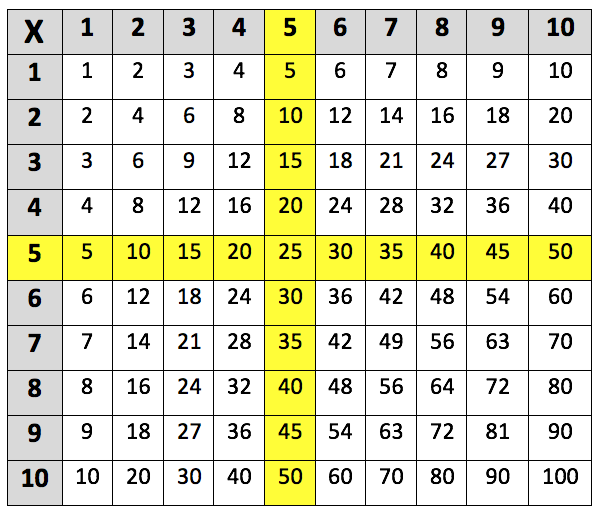Learning the 5 times table
Learning the 5 times table. The 5 times table up to 5 x 10 is highlighted in the multiplication grid below:

5 x 1 = 5
5 x 2 = 10
5 x 3 = 15
5 x 4 = 20
5 x 5 = 25
5 x 6 = 30
5 x 7 = 35
5 x 8 = 40
5 x 9 = 45
5 x 10 = 50
5 x 11 = 55
5 x 12 = 60
When do children learn the 5 times table?
In Year 2, children are taught the concept of multiplication and start by learning the 2, 5 and 10 times tables. Children will also learn the division facts for the 5 times table, such as:
5 ÷ 5 = 1 and 10 ÷ 5 = 2
Children are often taught the 2, 5 and 10 times tables first as there are patterns which make them easier to learn. A good knowledge of these times tables can also help children when they go on to learn more difficult times tables.
How to help children with the 5 times table?
One quick way of identifying multiples of 5 is to know that they always end in either a 5 or a 0. So, it is easy to tell if large numbers are in the 5 times table just by looking at the last digit. For example, the number 5040 is a multiple of 5, as it ends in a 0. Whereas, 4688 is not a multiple of 5 because it ends in an 8.
Another way that children could work out the 5 times table is by multiplying a number by 10 and then halving the answer. This rule works because 5 is half of 10, it would be useful for children who are confident in their 10 times tables. For example, instead of calculating 5 x 7, children could work out that 10 x 7 = 70, and then that half of 70 is 35. Therefore, 5 x 7 = 35.
When you have spare time with your child (such as after dinner), it is good practice to ask them to recite one of their time tables, for example, the 5 times table. This method or recalling can be really helpful, as the repetition will make the times tables stick in a child’s memory. If your child does learn through repetition, you could also invent multiplication songs or rhymes to sing throughout the day.
How does Learning Street help children with the 5 times table?
Repetition is key to learning your 5 times table, and in the Learning Street 8 year old courses, there is a constant focus on always practising times tables as this is the best way to improve. This is through times tables tests (to improve accuracy), tables races (to improve time), mental mathematics, maths problem solving and other fun activities such as mystery pictures.
Without a good knowledge of times tables, it can lead to problems in SATs, GCSEs and A Levels.
Our Courses
Click through to review the courses we have available
- Independent School 11 Plus Exam Preparation Courses
- Grammar School 11 Plus Exam Preparation Courses
- Primary School Improvement/Development Courses
Our 11 Plus Mock Exam Papers
Berkshire Reading 11 Plus Mock Exam Papers
Kendrick 11 Plus Mock Exam Papers Bundle ( packs 1-4)
Reading School ( FSCE) 11 Plus Mock Exam 1
Reading School ( FSCE) 11 Plus Mock Exam 2
Reading School ( FSCE) 11 Plus Mock Exam 3
Reading School ( FSCE) 11 Plus Mock Exam 4
Reading School ( FSCE) 11 Plus Mock Exam Papers Bundle (packs 1-4)
Berkshire Slough 11 Plus Mock Exams
Slough 11 Plus Mock Exam Papers Bundle (Packs 1-4)
Barnet 11 Plus Mock Exams
Henrietta Barnett 11 Plus Mock Exam 1
Henrietta Barnett 11 Plus Mock Exam 2
Henrietta Barnett 11 Plus Mock Exam 3
Henrietta Barnett 11 Plus Mock Exam 4
Henrietta Barnett 11 Plus Mock Exam Papers Bundle ( Packs 1-4)
QE Boys 11 Plus Mock Exam Papers Bundle (packs 1-4)
Bexley 11 Plus Mock Exams
Bexley 11 Plus Mock Exam Papers Bundle (packs 1-4)
Bromley 11 Plus Mock Exams
Newstead Wood School Mock Exam 1
Newstead Wood School Mock Exam 2
Newstead Wood School Mock Exam 3
Newstead Wood School Mock Exam 4
Newstead Wood School Mock Exam Papers Bundle ( Packs 1-4)
St Olave’s Grammar School Mock Exam 1
St Olave’s Grammar School Mock Exam 2
St Olave’s Grammar School Mock Exam 3
St Olave’s Grammar School Mock Exam 4
St Olave’s Grammar School Mock Exam Papers Bundle (Packs1-4)
Bucks 11 Plus Mock Exams
Bucks 11 Plus Mock Exam Papers Bundle (packs 1-4)
Cumbria 11 Plus Mock Exams
Queen Elizabeth’s Grammar School 11 Plus Mock Exam 1
Queen Elizabeth’s Grammar School 11 Plus Mock Exam 2
Queen Elizabeth’s Grammar School 11 Plus Mock Exam 3
Queen Elizabeth’s Grammar School 11 Plus Mock Exam 4
Queen Elizabeth’s Grammar School 11 Plus Mock Exam Papers Bundle (Packs 1-4)
Devon and Torbay 11 Plus Mock Exams
Devon and Torbay 11 Plus Mock Exam 1
Devon and Torbay 11 Plus Mock Exam 2
Devon and Torbay 11 Plus Mock Exam 3
Devon and Torbay 11 Plus Mock Exam 4
Devon and Torbay 11 Plus Mock Exam Papers Bundle (packs 1-4)
Colyton School FSCE 11 Plus Mock Exam 1
Colyton School FSCE 11 Plus Mock Exam 2
Colyton School FSCE 11 Plus Mock Exam 3
Colyton School FSCE 11 Plus Mock Exam 4
Colyton School FSCE 11 Plus Mock Exam Papers Bundle ( packs 1-4)
Dorset 11 Plus Mock Exams
Dorset 11 Plus Mock Exam Papers Bundle (packs 1-4)
Enfield 11 Plus Mock Exams
The Latymer School 11 Plus Mock Exam 1
The Latymer School 11 Plus Mock Exam 2
The Latymer School 11 Plus Mock Exam 3
The Latymer School 11 Plus Mock Exam 4
The Latymer School 11 Plus Mock Exam Papers Bundle ( packs 1-4)
Essex CSSE and FSCE 11 Plus Mock Exams
Essex CSSE 11 Plus Mock Exam 1
Essex CSSE 11 Plus Mock Exam 2
Essex CSSE 11 Plus Mock Exam 3
Essex CSSE 11 Plus Mock Exam 4
Essex CSSE 11 Plus Mock Exam Papers Bundle (packs 1-4)
Chelmsford County High School for Girls FSCE 11 Plus Mock Exam 1
Chelmsford County High School for Girls FSCE 11 Plus Mock Exam 2
Chelmsford County High School for Girls FSCE 11 Plus Mock Exam 3
Chelmsford County High School for Girls FSCE 11 Plus Mock Exam 4
Chelmsford County High School for Girls FSCE 11 Plus Mock Exam Papers Bundle ( packs 1-4)
Gloucestershire 11 Plus Mock Exams
Gloucestershire 11 Plus Mock Exam 1
Gloucestershire 11 Plus Mock Exam 2
Gloucestershire 11 Plus Mock Exam 3
Gloucestershire 11 Plus Mock Exam 4
Gloucestershire 11 Plus Mock Exam Papers Bundle (Packs 1-4)
Hertfordshire 11 Plus Mock Exams
Dame Alice Owen’s 11 Plus Mock Exam 1
Dame Alice Owen’s 11 Plus Mock Exam 2
Dame Alice Owen’s 11 Plus Mock Exam 3
Dame Alice Owen’s 11 Plus Mock Exam 4
Dame Alice Owen’s 11 Plus Mock Exam Papers Bundle (Packs 1-4)
Hertfordshire Southwest 11 Plus Mock Exams
Hertfordshire South West 11 Plus Mock Exam 1
Hertfordshire South West11 Plus Mock Exam 2
Hertfordshire South West11 Plus Mock Exam 3
Hertfordshire South West 11 Plus Mock Exam 4
Hertfordshire South West 11 Plus Mock Exam Papers Bundle (Packs 1-4)
Kent 11 Plus Mock Exams
Kent 11 Plus Mock Exam Papers Bundle (packs 1-4)
Kent Medway 11 Plus Mock Exams
Kent Medway 11 Plus Mock Exam 1
Kent Medway 11 Plus Mock Exam 2
Kent Medway 11 Plus Mock Exam 3
Kent Medway 11 Plus Mock Exam 4
Kent Medway 11 Plus Mock Exam Papers Bundle (packs 1-4)
Kingston-Upon-Thames 11 Plus Mock Exams
Stage 1 Tiffin 11 Plus Mock Exam 1
Stage 1 Tiffin 11 Plus Mock Exam 2
Stage 1 Tiffin 11 Plus Mock Exam 3
Stage 1 Tiffin 11 Plus Mock Exam 4
Stage 1 Tiffin 11 Plus Mock Exam Papers Bundle (Packs 1-4)
If a pupil passes the stage 1 process, they will be invited back to take a second test.
Stage 2 Tiffin 11 Plus Mock Exam 1
Stage 2 Tiffin 11 Plus Mock Exam 2
Stage 2 Tiffin 11 Plus Mock Exam 3
Stage 2 Tiffin 11 Plus Mock Exam 4
Stage 2 Tiffin 11 Plus Mock Exam Bundle (Packs 1-4)
Lancashire 11 Plus Mock Exams
Lancashire 11 Plus Mock Exam 1
Lancashire 11 Plus Mock Exam 2
Lancashire 11 Plus Mock Exam 3
Lancashire 11 Plus Mock Exam 4
Lancashire 11 Plus Mock Exam Papers Bundle (packs 1-4)
Lincolnshire 11 Plus Mock Exams
Lincolnshire 11 Plus Mock Exam 1
Lincolnshire 11 Plus Mock Exam 2
Lincolnshire 11 Plus Mock Exam 3
Lincolnshire 11 Plus Mock Exam 4
Lincolnshire 11 Plus Mock Exam Papers Bundle (packs 1-4)
Redbridge 11 Plus Mock Exams
Redbridge 11 Plus Mock Exam Papers Bundle (packs 1-4)
Sutton 11 Plus Mock Exams
Sutton 11 Plus Mock Exam Papers Bundle (packs 1-4)
If a pupil passes stage 1, they will be invited back to take a stage 2 test.
Stage 2 Sutton 11 Plus Mock Exam 1
Stage 2 Sutton 11 Plus Mock Exam 2
Stage 2 Sutton 11 Plus Mock Exam 3
Stage 2 Sutton 11 Plus Mock Exam 4
Stage 2 Sutton 11 Plus Mock Exam Papers Bundle (packs 1-4)
Trafford 11 Plus Mock Exams
Trafford 11 Plus Mock Exam Bundle (Packs 1-4)
West Midlands 11 Plus Mock Exams
West Midlands 11 Plus Mock Exam 1
West Midlands 11 Plus Mock Exam 2
West Midlands 11 Plus Mock Exam 3
West Midlands 11 Plus Mock Exam 4
West Midlands 11 Plus Mock Exam Papers Bundle (packs 1-4)
Wiltshire 11 Plus Mock Exams
Bishop Wordsworth’s 11 Plus Mock Exam 1
Bishop Wordsworth’s 11 Plus Mock Exam 2
Bishop Wordsworth’s 11 Plus Mock Exam 3
Bishop Wordsworth’s 11 Plus Mock Exam 4
Bishop Wordsworth’s 11 Plus Mock Exam Papers Bundle (packs 1-4)
South Wilts 11 Plus Mock Exam 1
South Wilts 11 Plus Mock Exam 2
South Wilts 11 Plus Mock Exam 3
South Wilts 11 Plus Mock Exam 4
South Wilts 11 Plus Mock Exam Papers Bundle (packs 1-4)
Wirral 11 Plus Mock Exams
Wirral 11 Plus Mock Exam Papers Bundle (Packs 1-4)
Upton Hall School Mock Exam Papers Bundle (Packs 1&2)
Yorkshire Calderdale 11 Plus Mock Exams
Yorkshire Calderdale 11 Plus Mock Exam 1
Yorkshire Calderdale 11 Plus Mock Exam 2
Yorkshire Calderdale 11 Plus Mock Exam 3
Yorkshire Calderdale 11 Plus Mock Exam 4
Yorkshire Calderdale 11 Plus Mock Exam Papers Bundle (packs 1-4)
Yorkshire-North 11 Plus Mock Exams
Erymsted’s 11 Plus Mock Exam 1
Erymsted’s 11 Plus Mock Exam 2
Erymsted’s 11 Plus Mock Exam 3
Erymsted’s 11 Plus Mock Exam 4
Erymsted’s 11 Plus Mock Exam Papers Bundle (Packs 1-4)
Ripon Grammar School 11 Plus Mock Exam 1
Ripon Grammar School 11 Plus Mock Exam 2
Ripon Grammar School 11 Plus Mock Exam 3
Ripon Grammar School 11 Plus Mock Exam 4
Ripon Grammar School 11 Plus Mock Exam Papers Bundle ( Packs 1-4)
Skipton Girls’ High School 11 Plus Mock Exam 1
Skipton Girls’ High School 11 Plus Mock Exam 2
Skipton Girls’ High School 11 Plus Mock Exam 3
Skipton Girls’ High School 11 Plus Mock Exam 4
Skipton Girls’ High School 11 Plus Mock Exam Papers Bundle (Packs 1-4)
Independent School Mock Exams
Independent School 11 Plus Mock Exam 1
Independent School 11 Plus Mock Exam 2
Independent School 11 Plus Mock Exam 3
Independent School 11 Plus Mock Exam 4
Independent School 11 Plus Mock Exam Papers Bundle (Packs 1-4)
Northern Ireland Transfer Test
Northern Ireland Transfer Test Mock Exam Paper 1
Northern Ireland Transfer Test Mock Exam Paper 2
Northern Ireland Transfer Test Mock Exam Papers 1-4 Bundle
Northern Ireland Transfer Test Mock Exam Papers 5-8 Bundle
Our Worksheets
We have over ten thousand worksheets listed that can be drawn on to focus on any area of primary school development. We have broken these down into subject and school year.



